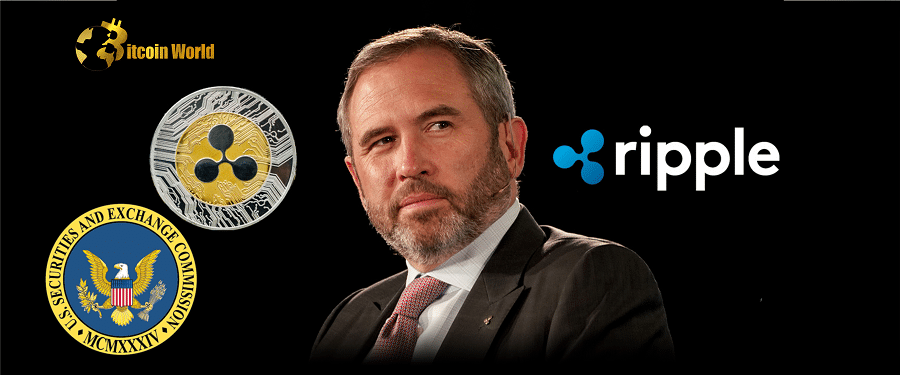The crypto world is closely watching the ongoing legal battle between Ripple Labs and the U.S. Securities and Exchange Commission (SEC). At the heart of the dispute? Whether XRP, the cryptocurrency closely associated with Ripple, should be classified as a security. Ripple CEO Brad Garlinghouse recently made headlines at the World Economic Forum in Davos, shedding light on the potential path to settlement and the broader implications for the crypto industry.
What’s the Core of the Ripple vs. SEC Lawsuit?
In December 2020, the SEC filed a lawsuit against Ripple and two of its executives, alleging that they conducted an “unregistered, ongoing digital asset securities offering.” According to the SEC, Ripple raised over $1.3 billion through the sale of XRP, which they argue should have been registered as a security offering. This lawsuit has become a landmark case in the crypto space, with its outcome potentially setting a precedent for how digital assets are regulated in the United States.
Ripple vehemently denies these allegations, maintaining that XRP is not a security. They argue that XRP functions more like a currency and should not be subjected to the same regulations as securities like stocks or bonds.
Garlinghouse’s Stance: No Settlement Without Clarity on XRP Status
Speaking at a fireside chat in Davos, Brad Garlinghouse made it unequivocally clear that a settlement with the SEC is only conceivable under one condition: the SEC must definitively state that XRP is not a security.
“The only way we would settle is if there’s clarity that XRP is not a security on a go-forward basis,” Garlinghouse stated. He further elaborated that under the current SEC Chairman Gary Gensler, the agency has adopted a broad view, seemingly considering “everything crypto is a security.”
This firm stance from Ripple’s CEO suggests that the company is prepared to see the lawsuit through to a judicial ruling rather than compromise on the fundamental question of XRP’s classification. Garlinghouse himself painted a stark picture of the settlement prospects, stating, “the Venn diagram for settlement is I suppose zero.”
Why is Ripple Fighting So Hard?
Garlinghouse emphasizes that Ripple’s fight is not just for themselves but for the entire cryptocurrency sector. He believes that a clear and favorable ruling for Ripple could provide much-needed regulatory clarity for the industry as a whole. This perspective is echoed by several prominent crypto entities who have shown their support for Ripple in this legal battle.
Support from the Crypto Community:
- Coinbase: One of the largest cryptocurrency exchanges, Coinbase, has filed a friend-of-the-court brief in support of Ripple.
- Blockchain Association: This industry group, advocating for blockchain technology, has also lent its support.
- SpendTheBits: Another crypto company joining the chorus of support for Ripple.
These entities recognize the broader implications of the SEC’s lawsuit and the potential chilling effect it could have on innovation within the crypto space. They believe that a ruling against Ripple could stifle growth and create unnecessary regulatory hurdles for the entire industry.
When Can We Expect a Resolution?
According to Garlinghouse, a decision in the lawsuit is anticipated this year, with a high degree of certainty for 2023. While acknowledging that he cannot dictate the judge’s timeline, he expressed his expectation for a ruling “within the next few months.”
The timeline for a resolution is crucial for both Ripple and the crypto market. The uncertainty surrounding the lawsuit has cast a shadow over XRP and Ripple’s operations. A favorable outcome could remove this uncertainty and potentially unlock new opportunities for the company and the cryptocurrency.
The XRP Supply Shock Theory
Adding another layer of intrigue to the situation is the perspective of Jeremy Hogan, a U.S. legal counsel and XRP advocate. Hogan has speculated that a settlement in the Ripple case could trigger a “supply shock” for XRP.
Understanding the Supply Shock:
- Decreased Supply: If the lawsuit is resolved favorably for Ripple, it could lead to increased institutional adoption and demand for XRP.
- Constant Demand: Existing demand for XRP, coupled with potential new demand, would remain constant or increase.
- Price Increase: With demand staying steady or rising while the available supply potentially decreases due to increased holding, the price of XRP could see a significant surge.
This theory gained traction when the price of XRP experienced a notable spike following both parties requesting a summary judgment in the case, indicating that the market is indeed sensitive to developments in the lawsuit.
Key Takeaways and What’s Next
The Ripple vs. SEC lawsuit remains a pivotal event for the cryptocurrency industry. Here are the key takeaways:
| Key Aspect | Details |
|---|---|
| Core Issue | Is XRP a security? |
| Garlinghouse’s Stance | No settlement without XRP clarity. |
| Settlement Probability | Low, leaning towards judicial ruling. |
| Timeline for Decision | Expected in 2023, potentially within months. |
| Industry Support | Significant support for Ripple from crypto companies. |
| Potential Impact | Sets precedent for crypto regulation, impacts XRP price. |
As the crypto world awaits the judge’s decision, the outcome of this case will undoubtedly have far-reaching consequences. It will not only determine the fate of Ripple and XRP but also shape the regulatory landscape for digital assets in the United States and potentially globally. The coming months promise to be crucial in this ongoing saga, and the crypto community will be watching closely for any updates.
Disclaimer: The information provided is not trading advice, Bitcoinworld.co.in holds no liability for any investments made based on the information provided on this page. We strongly recommend independent research and/or consultation with a qualified professional before making any investment decisions.


